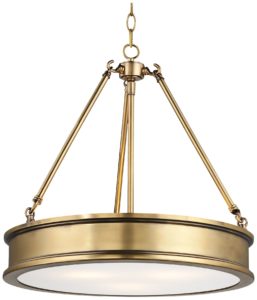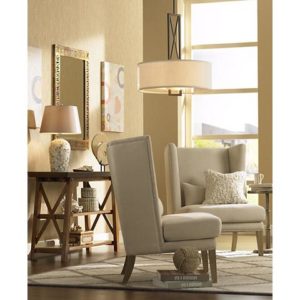From the experts at Lamps Plus, featuring designs from Minka Lavery, Five designer tips for lighting
1. Lighting is about contrast, not necessarily brightness.
“Good Lighting” has very little to do with how bright you can make a room. Often, we desire much less light to create a more social or serene environment even when the area to be lit is a workspace. Bad lighting can cause anxiety, headaches, and can interrupt the very activity a person is trying to accomplish.
The best way to conquer this goal is to provide ample, diverse sources of light throughout a room, and use adjustable controls like remotes, dimmers and switches to provide plenty of options for what to light up, how much and when. If you provide a wide range of appropriate options, you won’t have to get too specific and scientific about what is necessary and “right”.
2. Too much light in one place is just as bad as having not any light at all.
If you’re using one floor lamp as a corner lighthouse to brighten a room, you’ll have glaring light when you face toward it, and complete darkness everywhere else, increasingly so as you try to “fix” the problem by making that same floor lamp even brighter. Nothing will have the dramatic focus your design elements deserve.
Interiors need lighting beyond a simple flush-mount fixture in the center of the room. Floor lamps in dark corners, wall sconces or picture lights around artwork and dark walls, table lamps near seating are welcome additions to a bedroom or family room.
3. LED is the way to go, but know what you’re getting into!
Technology is changing our industry. In the last few years we’ve been introduced to the beginning of LED fixtures and bulbs. We will go through a lot of changes and adjustments and maybe even entirely new technologies in the near future.
If you’re using LED bulbs, in most cases you’re going to be fine. If a bulb goes out or doesn’t give the right quality of light, you can change the bulb. Even if there are three or four bulbs in the fixture you’re still fine. But if you’re dealing with a retail or office space with 20 fixtures, or a chandelier with 20 little LED bulbs, it’s time to be ready for new surprises. And if you’re dealing with fixtures that have permanently integrated LED panels, you’ll need to understand what you’re investing in and be prepared for the idea of obsolescence and disposable fixtures.
Perhaps a year or two from now a single LED bulb will burn out in a fixture or space with 20 bulbs or more. The replacement LED bulbs are available in a wider range of colors, qualities and brightness levels than incandescent and fluorescent bulbs ever were. It’s fully possible that the LED bulbs produced years from now will not match the years-old bulbs in the fixture. At best, it will be difficult to find that matching bulb. If it will be important for those later bulbs to match perfectly, you may want to buy extra bulbs now so they’ll have the best possibility of matching well.
LED fixtures with integrated panels are meant to last a long time, and it is simply not feasible to offer repair services for these items. Just like a flat-panel TV or a cell phone, these technologies are meant to be replaced when broken, or outdated. We haven’t lived in this era yet. Today, these items are disposable high-tech items. These aren’t fixtures you’re going to some day pass on to your kids. You’re investing in these items for their appeal today and the near future. Be ready and willing to part with them and to replace them when some of these fixtures don’t work as long as you expected.
 4. Hire an electrician to add the right fixtures, outlets and controls.
4. Hire an electrician to add the right fixtures, outlets and controls.
If someone is hiring an interior designer, the cost of those services plus the cost of the new furniture or labor involved to implement the design will dwarf any costs to hire an electrician to put in a junction box, wall switch or plug. Invest in the services of a good electrician to finish the lighting design right. Don’t limit your choices just to save a few skilled laborer hours and expenses.
The right choice isn’t to try to find a battery-powered fixture because you don’t have a wall outlet nearby. The right choice isn’t a pull chain flush-mount fixture because there is no wall switch in an old house. The right choice isn’t to swag a fixture ten feet over to a table or to put a chandelier on track fixtures because there isn’t any ceiling junction box. The right choice is to understand that if fixtures are hard to find, it’s because there is probably a better solution to the situation. That’s why we no longer have chandeliers with pull chains and nobody makes good battery powered table lamps. If you dread working with the electrician, you’re working with the wrong one. Hire a good, dependable, knowledgeable electrician to do the work right.
5. Have a sufficient lighting budget and plan from the beginning.
If you’ve involved yourself in a project you intend to be spectacular when complete, you need to budget a significant dollar amount for supplemental lighting fixtures and solutions that properly illuminate your design. Don’t get to the most important final step and be left with no money to shine light on your beautiful work.
A kitchen with a beautiful new $80,000 stove often is lit with the built-in hood lamp or a single recessed light. Gorgeous backsplash tiles are often left to be lit by under cabinet lights chosen at the end of the project nearly as an afterthought.
You should be spending at least $2-4 per sq. ft. to properly light a space with good quality lighting inside and out. $5-10 for a show-quality space. Another way to look at it would be at least 1% of the value of a home should be invested in the lighting to make it shine.
For more lighting tips or to view the Minka Lavery lighting collection visit LampsPlus.com.

